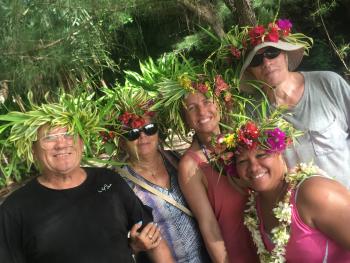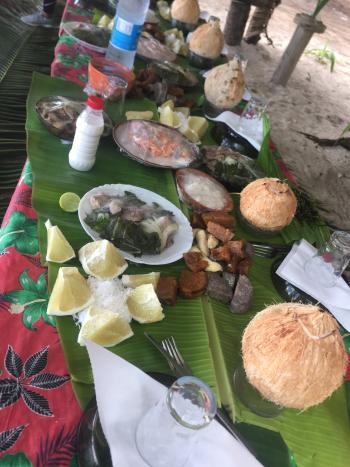A voyage to the not-often-visited Austral Islands
This article appears on page 40 of the February 2020 issue.
Since I started reading International Travel News in the early 1990s, I had heard the occasional report that the ships supplying the various island groups in French Polynesia also carry tourists. With two weeks to spare before the end of the 2019 cyclone season, when I would rejoin my yacht in Raiatea, the timing was perfect for me to find out for myself.
French Polynesia consists of five distinct archipelagos. Everyone’s heard of the Society Islands, which include Tahiti, Bora Bora and Moorea, but there are also the Tuamotus, Gambiers, Marquesas and Australs, which are much less familiar. I had already spent time on many of those islands, but I’d never been to the Australs, the most remote and least visited group. So that was where I wanted to go in late May 2019.
Getting started
Each archipelago has its own supply ship; the one serving the Australs is called the Tuhaa Pae IV. Consulting my most trusted travel advisor, Google, I learned that there are two distinct itineraries available: one lasting six to nine days, which visits four of the five islands (Rimatara, Rurutu, Tubuai and Raivavae), and a longer itinerary, lasting 11 days, which adds Rapa to the route, the most southerly and most remote island of this already remote archipelago. Although the Rapa cruise occurs only once every two months, it was the one I wanted.
Writing to the email address provided on the website for the ship did not elicit a response, so I called their office (+689 40 41 36 16) and made contact with a woman named Manava, who provided me with a different email address (mtauira@snathp.com), which got the ball rolling. Manava wanted a copy of my passport as well as a completed questionnaire, which she sent.
At the time of my voyage, the price of the least expensive single cabin was $1,700, but it has since gone up to around $2,564. Credit card payment is not accepted, so it was agreed that I would pay in cash upon arrival.
There were two categories of passengers on board, the locals and the tourists. The latter pay three times the local price, eat in a separate dining room and have excursions on each of the islands. Nonresidents cannot get the local rate.
The islands
I arrived in Tahiti a day early to pay for the trip and to partially overcome the expected jet lag. Although I got to the ship about two hours early, I was allowed on board and shown to my stateroom, my home for the next 11 days.
It took us two days to get to our first island, Rimatara, located about 340 miles from Tahiti. There were only three nonlocals on board, myself and a French couple from New Caledonia.
All of the islands were quite beautiful and sparsely touristed. The streets were clean, the beaches, pristine, and the locals could not have been any friendlier. With the exception of the last island, Rapa, it was hard to distinguish one island from another, as their similarities were significantly greater than their differences. But I’ll give it a try.
Perhaps Rimatara had the prettiest beaches. The post office and recycling stations were beautifully painted. After a bike tour, we were given a luau lunch. Later in the day, the locals showed us how to construct hats using only plant fibers and flowers.
Our second island was Rurutu, where the weather did not completely cooperate. But the overcast skies made for some good photography.
Unique to this island were its caves, which we got a chance to explore. The island was formed about 12 million years ago by the Macdonald hotspot, probably the only McDonald’s it will ever see!
Next up was Tubuai, the administrative capital of the Australs. Sighted by Captain Cook, the island was visited by a second European, Fletcher Christian, after his infamous mutiny.
Still somewhat tropical, it was noticeably cooler there than in Tahiti. Along our travels, we stopped at a lovely pension called Toena and had tea with its French proprietors.
Another overnight passage delivered us to our penultimate island, Raivavae. Of all the islands, this was the most manicured. There were several beautiful pensions, and the proprietors of one took us to their private island in the lagoon and fed us a scrumptious lunch.
Last but certainly not least was Rapa, which was for me the highlight of the trip. Whereas the other islands were tropical in appearance, the landscape of Rapa appeared more like New Zealand or Scotland. While not frigid, the temperature in early June warned of winter’s imminent arrival.
Rapa is also unique in its geological, cultural and linguistic history. And, located so far south, it took us three full days to get back to Tahiti from there.
Everyone I met, from the staff on board to the local passengers and the native islanders, could not have been more friendly. They did everything possible to share their culture and lifestyle with us. Several of the crew and islanders spoke English, but speaking some French really came in handy.
The food was adequate but was far from the French gourmet standard that I had expected. My fellow tourists said that the ship serving the Marquesas had much better food.
All told, it was an excellent voyage, and I would like to return someday to spend more time in these enchanted, out-of-the-way islands.


